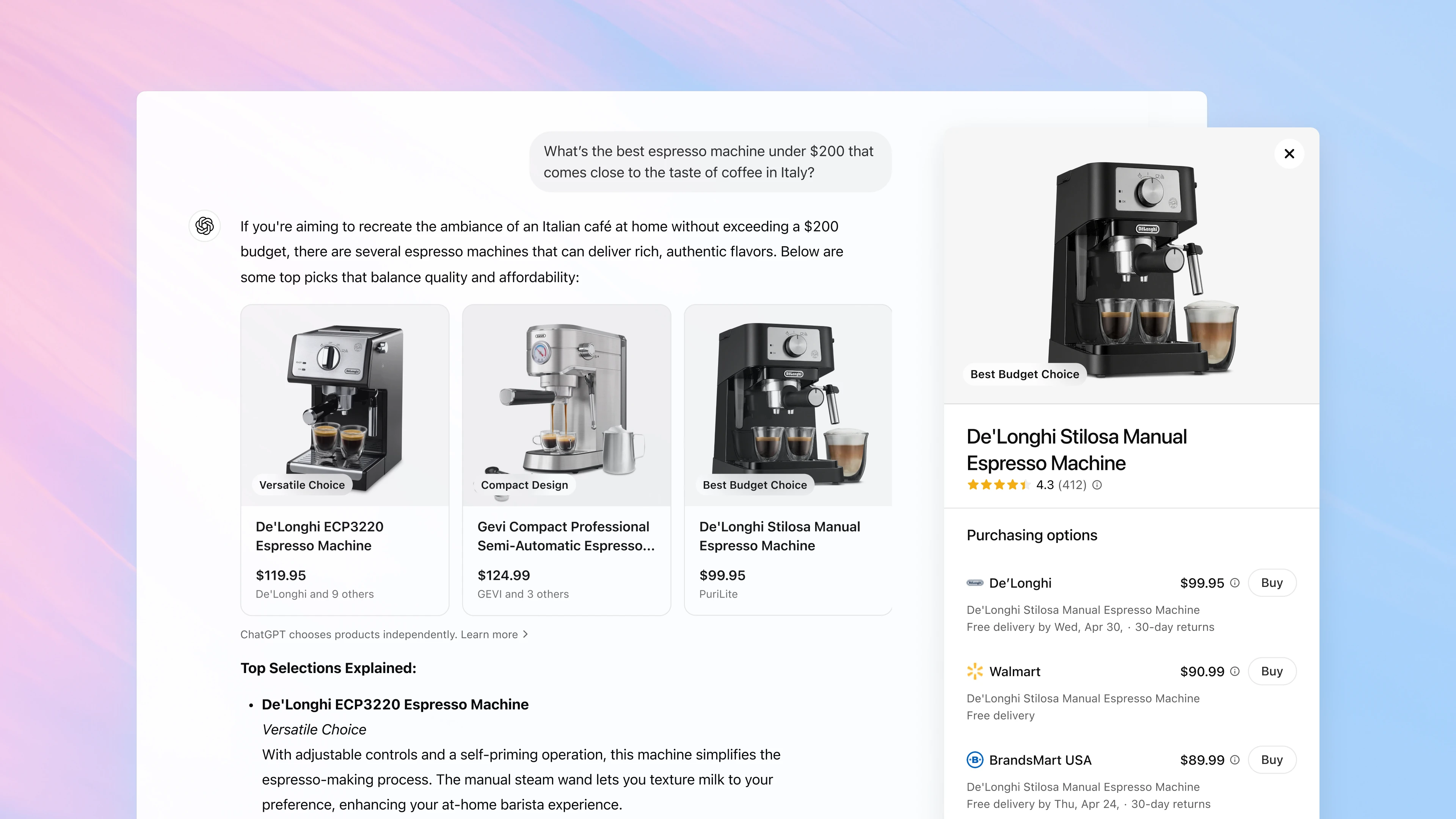How to Improve Your Ecommerce Store’s Visibility in ChatGPT Shopping Results
New conversational shopping features in ChatGPT are changing the way consumers discover products. Join us as we explore what this functionality looks like exactly, the impact on ecommerce retailers, and best practices for improving visibility in ChatGPT shopping results.
Written By
Edward Matthews

The way consumers research, discover and purchase products online is evolving, fast. Shoppers are increasingly moving away from traditional search for product inspiration, instead turning to agentic AI experiences.
Recognising this shift in how product discovery happens, AI giant OpenAI has introduced product recommendations as part of the ChatGPT search experience. According to a LinkedIn post by OpenAI, the company is “experimenting with making shopping simpler and faster to find, compare, and buy products in ChatGPT”.
This roll-out follows rumours of a possible integration between OpenAI and Shopify, which, as of this article’s publication date, is yet to be confirmed. It also comes after announcements by both Visa and Mastercard about revolutionary AI commerce initiatives, as well as news of Google trialling agentic checkout in its AI Mode – further demonstrating the shift towards AI-powered commerce.
In this article, we explore what the rise of conversational commerce means for ecommerce brands and how you can start optimising your online store to improve visibility in ChatGPT’s recommended product results.
New ChatGPT commerce features explained
The online shopping experience can often involve a lengthy research journey, multiple browser tabs, and time-consuming price comparisons. ChatGPT’s new shopping features aim to simplify and centralise this process for consumers.
Now, when ChatGPT detects shopping intent in a user query, such as “What’s the best daytime moisturiser for someone with sensitive skin?”, or “Recommend a good waterproof coat for men, below £100”, it can recommend relevant products directly in the conversation.
Recommended products are displayed in a visual carousel format, with each product tile featuring a title and price. Some tiles also feature labels, such as “Best budget choice” or “Compact design”, which are generated by ChatGPT based on user reviews and product detail page (PDP) content.
ChatGPT also provides users with direct links to sites where each product is available, making price comparison much more straightforward.
In the example below from OpenAI, the user asks for espresso machine recommendations within a particular budget. ChatGPT shares three recommendations in a carousel, each with price details and a USP identified. A list of retailers is displayed when the user clicks on a product tile.

Image source: OpenAI
There are currently no paid placements in ChatGPT’s recommendations. Instead, suggestions are shaped by a range of factors, including:
- specific criteria provided by the user;
- the product’s relevance;
- quality of structured data and PDP content;
- customer reviews and ratings; and
- perceived brand authority.
Note that this is expected to evolve as OpenAI continues to improve the ChatGPT shopping experience.
What does the rise of AI-powered product discovery mean for ecommerce retailers?
The launch of commerce functionality within ChatGPT reflects a wider shift in consumer behaviour. Online shoppers are increasingly turning to agentic AI environments to conduct product discovery and drive informed purchase decision-making.
According to research, 22% of shoppers already use AI for product discovery and inspiration at least occasionally, with Gen Z shoppers 10x more likely than baby boomers to frequently use AI to discover new products.
As such, ecommerce retailers – especially those with a younger target demographic – must adapt their strategies to ensure visibility in AI search results. Moving decisively and strategically can help brands to tap into a new audience emerging through AI platforms.
With other players in the AI space, including the likes of Microsoft and Anthropic, likely to follow suit, it’s the brands who act quickly to embrace AI and conversational commerce that stand to gain the competitive edge.
Optimising your online store for ChatGPT Shopping visibility
Improving your chances of appearing in ChatGPT’s shopping results will require a blend of traditional SEO, structured data best practices, and strategic content optimisation tailored for AI discovery.
1. Prioritise structured data & schema markup
Structured data is information about a web page that’s organised in a pre-defined, consistent format, making it easy to store, retrieve and analyse. Schema markup is a specific type of structured data, typically used to indicate to AI and search engines the content and context of a page.
Structured data is essential for helping AI tools understand and trust your product content, and therefore key in determining ChatGPT product visibility.
As such, brands should be:
- using product schema to define product names, prices, availability and reviews;
- implementing FAQ, review and breadcrumb schema where appropriate; and
- adding brand and organisation schema to reinforce your business’ identity and legitimacy.
2. Create high-quality PDP content
ChatGPT and other AI tools rely on high-quality, search-friendly content to understand and surface product information. Investing time to improve the quality of your PDP content is therefore recommended. You can do this by:
- using clear, descriptive product titles that reflect consumer search intent and conversational queries (e.g. “Women’s White Linen Shirt” rather than “Item 278530”);
- writing detailed product descriptions that highlight what matters to buyers, focusing on benefits and USPs (using natural language and short paragraphs); and
- adding FAQs to PDPs, addressing common concerns and questions (such as “Can this shirt be dry cleaned?” or “Is this shirt true to size?”).
This will help to make your content more discoverable, not only by AI models, but also by traditional search engines.
3. Focus on your ecommerce site’s crawlability & indexability
Much like in SEO, crawlability and indexability are crucial factors when optimising for AI search visibility. AI crawlers need to be able to discover, access and understand your content in order to accurately summarise and display it.
Best practices include:
- ensuring your robots.txt file is correctly configured to give access to OpenAI’s crawler “OAI-SearchBot”;
- checking your sitemap is up to date and well-structured;
- using tools like Google Search Console to identify and fix issues like broken links and slow server response times; and
- following ecommerce accessibility best practices.
4. Maximise positive review visibility
Reputation signals are another key ranking factor within ChatGPT Shopping. ChatGPT draws on real product reviews from various sources – including your ecommerce store, social media and review sites – when recommending products in its search results.
With this in mind, it’s important to maximise positive review visibility across touchpoints. Tools such as Okendo and Yotpo enable you to capture and showcase reviews and other social proof across your ecommerce store. Incentivising customers to leave reviews in exchange for loyalty points, discounts and other perks is a popular strategy.
Meanwhile, we’d recommend encouraging customers to leave reviews on third-party sites like Google, Trustpilot and Reddit – platforms that are frequently crawled and referenced by AI tools.
5. Build topical authority
By positioning your brand as an expert, you can improve the likelihood of being referenced in ChatGPT Shopping results. Here are some things to consider when trying to build authority in your niche – both on your own website and on high-authority third-party sites:
- Publish educational blog content that links back to your PDPs. This could include things like how-to articles, industry trend round-ups, and resources linked to key themes in your niche. Ensure this long-form content answers common customer questions, adding value to readers.
- Regularly refresh your blog content to cover trending themes that customers might ask AI tools about.
- Create comprehensive help centre content that directly addresses frequently asked questions.
- Earn mentions in trusted third-party content, like editorial reviews, “best of” product round-ups, and shopping guides. Pitch your products to journalists, bloggers and content creators, aiming to increase your brand’s digital footprint and achieve placement in high-authority publications.
6. Align store content with conversational search queries
AI tools like ChatGPT leverage Natural Language Processing (NLP) to understand user intent and map this to relevant content – in this case, recommended products. They prioritise natural language that engages readers and provides valuable information, above exact-match keywords.
By implementing the following advice, you can ensure your content aligns with how consumers interact with generative AI tools.
- Incorporate long-tail phrases that mirror how people ask questions (e.g. “What’s a good running shoe for someone with a neutral gait?”).
- Create comparison content that answers buying intent (e.g. “Best running shoes for a neutral gait”).
- Use everyday phrases that reflect how people naturally speak – and search on ChatGPT.
- Use headings, bullet points and short paragraphs to make it easier for AI to parse your content.
Keep up with AI search trends with Swanky
The way AI shapes product discovery is evolving fast. At Swanky, we stay on top of emerging AI and marketing trends to ensure the brands we work with are best positioned to succeed.
To discuss any of the themes in this article with us or find out more about our ecommerce marketing services, please reach out to our team.

